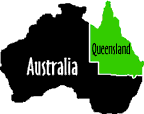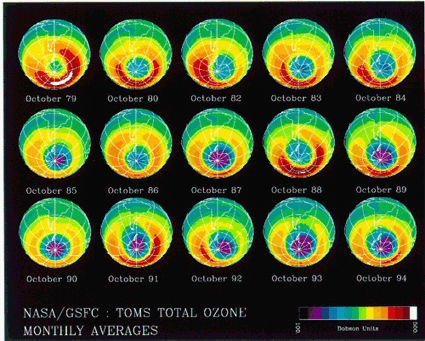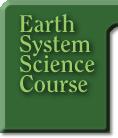Ozone
Scenario
| While
doing work in atmospheric chemistry that led to an understanding
of how the ozone layer forms and decomposes, Nobel Prize
winner F. Sherwood Rowland remarked to his wife, "the
work is going well, but it looks like the end of the world."
|
Stratospheric
ozone is a very important gas because it absorbs most of the
sun's harmful ultraviolet radiation and prevents it from reaching
Earth's surface. However, the ozone layer has been depleting
as the result of a complex set of circumstances and chemistry.
Ozone depletion
is the term commonly used to describe the thinning of the earth’s
protective stratospheric ozone layer. Ozone depletion occurs
when the natural balance between the production and destruction
of stratospheric ozone is tipped in favour of destruction. Natural
phenomena, such as volcanoes, and human-generated ozone depleting
substances (ODS) can upset that balance, removing ozone faster
than nature can produce it.
 One
of the negative effects of ozone depletion is an increase in
the number of people suffering from skin cancer. The relationship
between skin cancer and uv radiation is well established. People
of fair skin are generally more prone to skin cancer. For example,
Queensland, Australia, which has high natural rates of uv radiation
and a population largely of Northern European descent, has the
highest rate of skin cancer in the world. One
of the negative effects of ozone depletion is an increase in
the number of people suffering from skin cancer. The relationship
between skin cancer and uv radiation is well established. People
of fair skin are generally more prone to skin cancer. For example,
Queensland, Australia, which has high natural rates of uv radiation
and a population largely of Northern European descent, has the
highest rate of skin cancer in the world.
Ozone depletion
is monitored with a Total Ozone Mapping Spectrometer (TOMS),
which is a satellite instrument that measures total vertical
ozone column concentrations. TOMS measures the total solar radiance
incident on the satellite and, by comparing it to the uv radiation
scattered back from the atmosphere, is able to compute total
ozone amounts. Because it depends upon scattered solar radiation,
TOMS does not work at night. As a result, between the first
day of fall and the first day of spring, there will be parts
of the high latitudes that will have no data. This area begins
at the South Pole on the first day of fall, reaches its maximum
on the first day of winter, and then shrinks back to zero on
the first day of spring. Ozone measurements given by TOMS are
in Dobson units--a measure of total ozone in a vertical
column. One Dobson unit is equal to a depth of 0.001 mm at standard
temperature and pressure.
A TOMS instrument
was carried aboard Nimbus-7. From November 1, 1978 to May 6,
1993, this satellite provided the only source of high-resolution
global information about ozone. Meteor-3, a Russian satellite,
also carried a TOMS. It stopped operating on December 27, 1994.
From that date until September 12, 1996, no TOMS data were available.
Since then, however, the Earth Probe TOMS and ADEOS TOMS have
provided data. For more information about TOMS, visit
the TOMS Home
Page.

Situation
In the 1970s, researchers began to think that human activity
could affect the ozone. At the time, they were focusing
on the exhaust from supersonic airplanes and the space shuttle.
However, after studying other possible causes for ozone depletion,
the international community came to a consensus that certain
synthetic chemical compounds called chlorofluorocarbons (CFCs)
were largely responsible for the ozone loss. As a result, the
Montreal
Protocol was adopted in 1987, calling for the worldwide
elimination of CFCs and other ozone-destroying substances. So
far, the Montreal Protocol has been signed by more than 160
nations.
The Protocol
has been updated several times, most recently in 1995. Since
knowledge of the ozone depletion problem continues to increase
rapidly, the director of the United Nations Environment Programme
(UNEP) plans another update. The
next meeting to update the Protocol will occur in the year 2000
and once again be held in Montreal.
There are
still many (including some vocal scientists) who would like
to abandon the Montreal Protocol. Some think a causal relationship
has not been proved, while others contend that enforcement of
the Montreal Protocol is too costly. In fact, in 1996, legislation
was introduced in the US Senate that would have ended United
States compliance. There is also concern about developing
countries and countries that have not yet signed the protocol.
The government
of Queensland, Australia, is concerned that the Montreal Protocol
is too lax on its control of some substances. The Queensland
government has called upon your Earth Systems Science team to
act as consultants to review the many issues that surround ozone
depletion. Your role is to evaluate the current understanding
of the cause-and-effect interrelationships of Earth's systems
related to ozone depletion. The Queensland officials who will
attend the 2000 Montreal Protocal meeting will use your information
to prepare for the meeting.
Assignments
Over the next two weeks (Week A and Week B) you will work individually
and in teams to address the ozone depletion situation. Use the
links below to access your assignments.
Week A: Teacher
as Problem Solver
Private
Theory Activity and Rubric
Individually,
identify what you believe to be true and the reasons for why
you have those beliefs regarding ozone depletion.
Week A: Teacher
as Problem Solver
Knowledge-Building
Activity and Rubric
As
a team, build ESS knowledge about the ozone depletion event
described in the scenario, and develop a problem statement.
Week B: Teacher
as Model Builder
Model-Building
Activity and Rubric
Using
your team's original or revised problem statement, build an
ESS model that includes the ESS relationship statements and
evidence that support your conclusions (recommendations or solutions).
[
Back
to Outline ]
[
Home ] [ Intro
] [ Guide ] Outline [ Classroom
]
HTML code
by Chris Kreger
Maintained by ESSC Team
Last updated July 25, 2000
Privacy
Statement and Copyright©
1997-2000 by Wheeling Jesuit University/NASA Classroom of the Future™. All
rights reserved.
|



